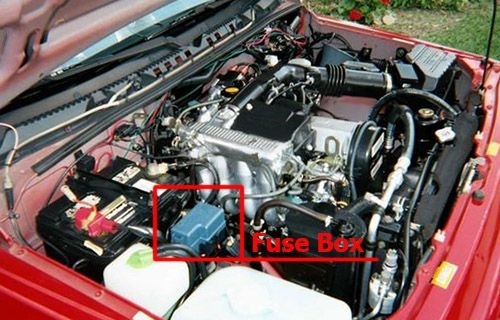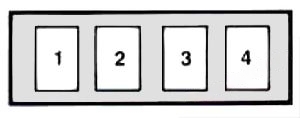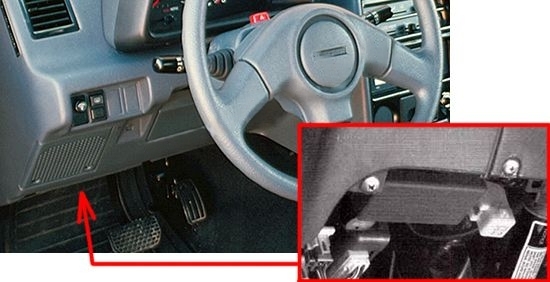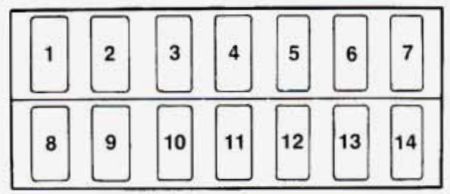Chevrolet Tracker (1993-1998) fuse box and relay Diagrams
The Chevrolet Tracker, produced from 1993 to 1998, is a compact SUV that gained popularity for its off-road capability and affordability. Known for its rugged design and simplicity, the Tracker appeals to those seeking a practical vehicle for both urban and adventurous driving. An essential part of the Tracker’s functionality lies in its electrical system, which is managed and protected by the fuse box and relays.
The fuse box in the Chevrolet Tracker is crucial for protecting the vehicle’s electrical circuits from overloads and short circuits. These circuits power various components, including the lighting, engine management, climate control, and interior features such as the radio and power windows. The Tracker typically features a main fuse box located under the dashboard on the driver’s side. This fuse box contains fuses that correspond to specific circuits within the vehicle.
Each fuse is designed to “blow” or interrupt the circuit when there is excessive current flow, thereby protecting sensitive components from damage. If a system like the headlights or air conditioning fails to operate, checking the relevant fuse is an important first step in diagnosing the problem. Replacing a blown fuse with one of the correct amperage is crucial to maintaining the system’s functionality.
Relays in the Chevrolet Tracker serve as electrically operated switches that control high-current systems. These systems include the starter motor, fuel pump, and radiator cooling fan. Relays allow these components to be operated by low-power circuits, preventing the vehicle’s wiring and switches from being overloaded. This setup ensures that high-demand components receive sufficient power without compromising safety.
Regular inspection and maintenance of the fuse box and relays in the Tracker are vital for avoiding electrical problems. A faulty relay or blown fuse can lead to malfunctions, such as the engine failing to start if the starter relay is defective, or overheating issues if the cooling fan relay is compromised. Ensuring that fuses and relays are replaced with the correct specifications helps keep the vehicle’s electrical system in good working order.
Understanding the roles of the fuse box and relays allows Tracker owners to better maintain their vehicle’s electrical systems, ensuring reliable performance. This attention to detail helps preserve the vehicle’s functionality, making the Chevrolet Tracker a dependable choice for both everyday use and off-road adventures. With proper maintenance, the Tracker remains a practical and versatile vehicle that meets the demands of its drivers.
MUST READ: DYI – How to Check Car Fuses?
(1993-1998) Chevrolet Tracker fuse box and relay with Diagram
WARNING
- Never replace a fuse with one that has a higher amperage rating.
- A fuse with a too-high amperage could damage the electrical part and cause a fire.
- On no account should fuses be repaired (e.g. patched up with tin foil or wire) as this may cause serious damage elsewhere in the electrical circuit or cause a fire.
- If a fuse blows repeatedly, do not keep replacing it. Instead, have the cause for the repeated short circuit or overload tracked and fixed.
- Terminal and harness assignments for individual connectors will vary depending on vehicle equipment level, model, and market.
Chevrolet Tracker 1993-1998 fuse assignment
- Cigar lighter (power outlet) fuse in the Chevrolet Tracker is the fuse №7 in the Instrument panel fuse box.
Year of production: from 1993, 1994, 1995, 1996, 1997, 1998
Engine Compartment Fuse Box (Main fuses)
Fuse box location
The main box in the engine compartment on the right side.

1993-1995

1996-1998
Fuse box diagram (1993-1995)

Assignment of the fuses in the Main Fuse Box (1993-1995)
| № | Circuit | A |
|---|---|---|
| 1 | Generator to Battery Circuit | 60 |
| 2 | Circuits Only Active When Ignition Switch is in “ACC”, “ON” or “START” | 50 |
| 3 | Circuits Always Active | 40 |
| 4 | Circuits Always Active | 30 |
Fuse box diagram (1996-1998)

Assignment of the fuses in the Main Fuse Box (1996-1998)
| Name | Circuit |
|---|---|
| BATT | All Electrical Load |
| ABS | Anti-Lock Brake System |
| IG | Ignition, Lighter, Radio, Wiper/Washer, Rear Defogger. Turn Signals, Back-up Lamps, Heater |
| LAMP | Taillamps, Dome Lamps, Stop Lamps, Horn, Hazard Lamps |
| H/L,L | Left Side Headlamp |
| H/L,R | Right Side Headlamp |
| FI | Fuel Injection System |
| A/C | Air Conditioning |
Instrument Panel Fuse Box
Fuse box location

It islocated under the left side of the instrument panel.
Fuse box diagram

Assignment of the fuses in the Instrument Panel
| № | Circuit | A |
|---|---|---|
| 1 | 1993-1995: Right Headlight 1996-1998: Empty |
15 |
| 2 | 1993-1995: Left Headlight; High Beam Indicator Light 1996-1998: Empty |
15 |
| 3 | 1993-1995: Taillights; Interior Light; Sidemarker Lights; Instrument Cluster Lights 1996-1998: Dome Lamp, Sidemarker Lamps, Parking Lamps, License Plate Lamp, Instrument Panel Illumination |
15 |
| 4 | Stop Lights; Horn | 15 |
| 5 | Hazard Lights | 15 |
| 6 | Door Lock (Option) | 20 |
| 7 | Lighter; Radio | 20 |
| 8 | 1993-1995: Ignition System; Warning and Indicator Lights 1996-1998: Ignition System, Warning and Indicator Lights, Gages, Four-wheel Drive System |
15 |
| 9 | Turn Signal Lights; Back-up Lights | 15 |
| 10 | Wiper/Washer | 15 |
| 11 | Rear Defogger | 15 |
| 12 | Heater | 25 |
| 13 | 1993-1995: Rear Wheel Anti-Lock Main Relay 1996-1998: Empty |
20 |
| 14 | 1993-1995: Electronic Fuel Injection Main Relay 1996-1998: Empty |
15 |
| * Fuses for the Airbags are located next to the instrument panel fuse block. |
Conclusion
For owners and enthusiasts of classic Chevrolet Tracker 1993-1998, understanding the fuse box and relay systems is essential for vehicle maintenance. Regular inspection and maintenance of these components helped ensure the vehicle’s longevity and reliability, preserving its status as a symbol of Chevrolet’s craftsmanship and innovation in the automotive industry during that era.